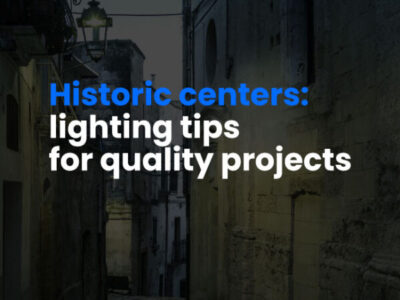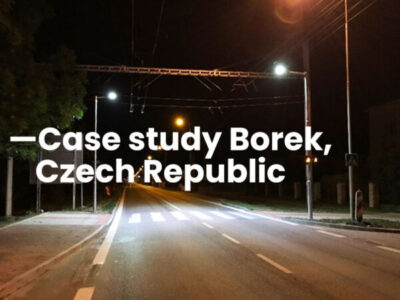More than 315 lighting installations of pedestrian crossings
Between 2017 and 2021, Niteko realized more than 315 lighting installations of pedestrian crossings in Czech Republic, becoming a point of reference in the urban lighting of this central European country.
The high customization of our products allowed us to realize 145 different solutions. There are no three identical pedestrian crossings among them, because we carried out a customized study depending on the place of installation.
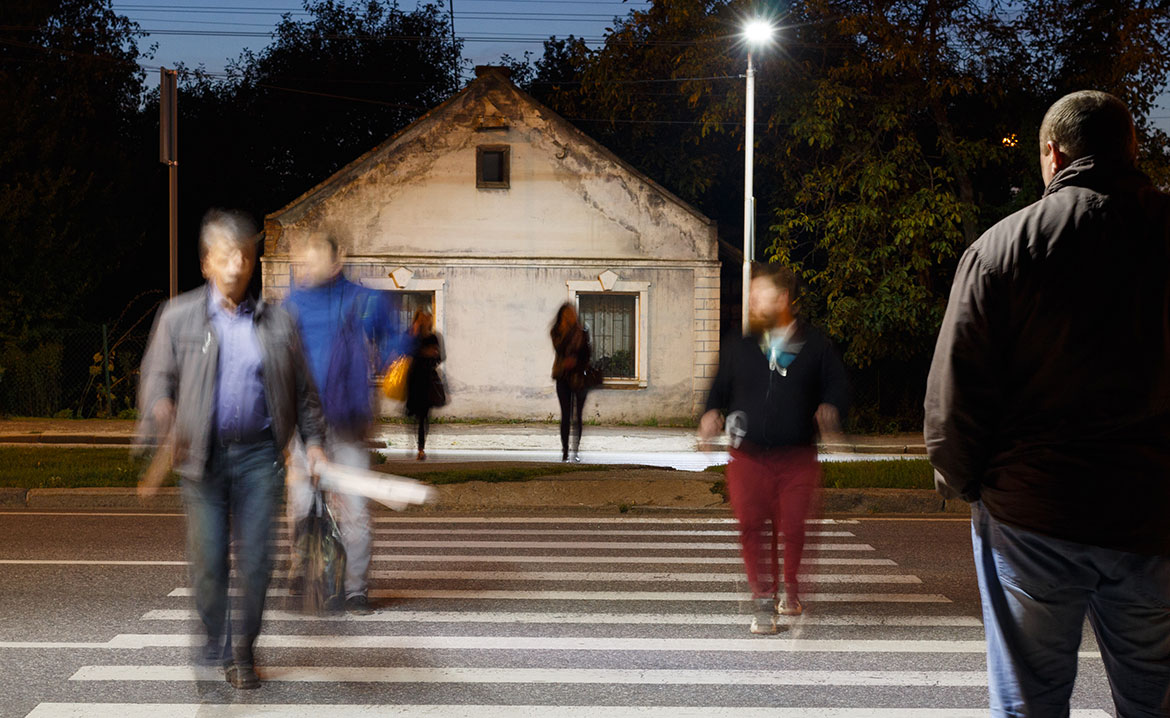
Pedestrians or drivers rarely know how difficult it is to illuminate a pedestrian crossing, respecting at the same time all the rules.
Only the best professionals are able to meet all the needs highlighted in the technical specifications, and Niteko succeeded in doing it.
We won important tenders with our Czech partner JIPOL and provided several Czech Republic cities with lighting fixtures specific for pedestrian crossings with critical issues.
Our installations have fully complied with the UNI/TS 11726 technical specification and achieved both the best results and the greater savings.
UNI/TS 11726 technical specification.
Areas taken into consideration
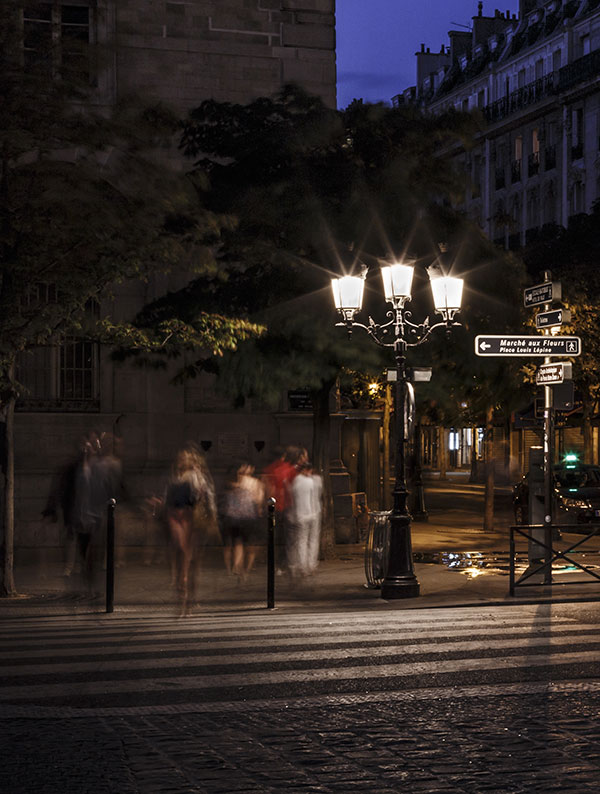
UNI/TS 11726 technical specification provides guidance on the lighting design of pedestrian crossings in motor traffic roads and in the scope of UNI 11248.
First, this technical specification takes into account the safety status of the lighting system i.e., the operating status that has to guarantee adequate visibility conditions for both drivers and pedestrians, so that the latter can cross the road safely.
It divides the area into waiting area – the section adjoining the carriageway where pedestrians wait the best moment to cross the road, – and crossing area, which is perpendicular to the carriageway.
It also distinguishes the undertaking area from the study area of the pedestrian crossing. The first one is identified in the lane with the opposite direction to the one taken as a reference, where the pedestrian must be seen while he is moving, while the study area identifies the area of the road whose width is equal to three times the width of the crossing and it is centered on the axis of transverse symmetry of the crossing area.
Objectives to be achieved
If the designer wants to meet the rule with his results, he needs to:
- Highlight the waiting area, the crossing area, and the possible undertaking area with respect to street lighting
- Make the pedestrian visible for the driver
- Make the street properly visible for the pedestrian
- Respect the environment and the adjoining houses
Light diversification
The width of the pedestrian crossing area is equal to the length of the carriageway and its length is equal to the width of the zebra crossing.
The two fixtures illuminating the pedestrian crossing need to be different from those illuminating the rest of the street.
By diversifying the lighting of the two sections, the driver can clearly see the crossing area and the pedestrian can feel safer because he has adequate visibility conditions allowing him to notice in time the presence of vehicles.
For example, if you use a warm light of 3,000 K for the street, you need to diversify the lighting fixtures of the pedestrian crossing by using a cold white light of 4,000 K or 5,000 K.
The difference of the two colors temperatures must be at least 1,000 K.
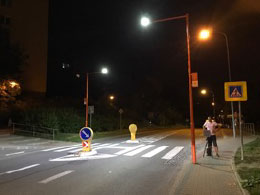 Pedestrian crossing in Brno- Hraničky (2017)(2017)
Pedestrian crossing in Brno- Hraničky (2017)(2017)
Here, Niteko company has provided lighting fixtures with a color temperature of 5,000 K and a customized optic – 50° right to diversify the area from the other fixtures with 3,000 K color temperature.
Vertical lighting
When dealing with pedestrian crossings, vertical lighting is more suitable than the horizontal one.
Its values are measured 1 meter above the ground because light must make pedestrians visible to the drivers and the driver has to be able to recognize the vertical light wall already from a distance, so to understand that he is close to a pedestrian crossing.
Objective: maximum safety.
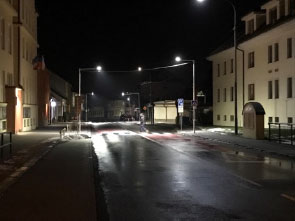 Pedestrian crossing in Blatná – 2018
Pedestrian crossing in Blatná – 2018
Our Guida S lighting fixtures of 5,000 K direct the beam of light directly on the zebra crossings, where a customized rotation of the optics makes pedestrians immediately noticeable and avoids glaring drivers
Energy saving
The use of customized optics is the best solution to combine energy saving and absence of glare.
For best results, you only need to use lighting fixtures with lower power and to direct the beam of light onto the area you want to illuminate.
On the contrary, a less precise optic needs a higher power to achieve the same light intensity, and this means a greater consumption.
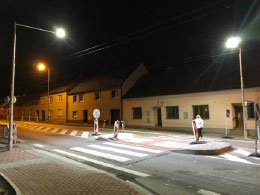 Pedestrian crossing in Borek – 2017
Pedestrian crossing in Borek – 2017
Usually, traditional optics offer a 45° or 50° rotation and can force the designer to intensify the power of the fixtures, in order to achieve the desired lighting.
Depending on the case, our optics are instead customized with 15°, 30°, 35° or 90° rotation, allowing us to illuminate the pedestrian area with the highest efficiency and the greater saving.
Environmental aspects
Environmental aspects and minimization of intrusive light towards the adjoining houses are one last, but not least requirement highlighted by the rule.
The beams of light on the windows could bother the circadian rhythm of the people living there. So, it is essential not to disperse light in the surrounding areas.
Sleep-wake rhythms are extremely important for the organism, and it is very important not to alter them.
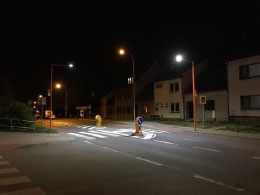 Pedestrian crossing in Brno-Hraničky.
Pedestrian crossing in Brno-Hraničky.
Niteko avoided bright discomfort and directed the beam of light onto the zebra crossings by using customized optics. As you can see from the photo, the houses are in the half-light.
Niteko projects advantages:
• – 60% energy saving
• Pedestrian safety
• Absence of glare for drivers
• Absence of light disturbances for the adjoining houses
• High luminous efficiency
f you have any questions about our products or if you need assistance or information, please contact us by message, e-mail, or call us.
CONTACT US0 Comments
Leave a reply
You must be logged in to post a comment.




